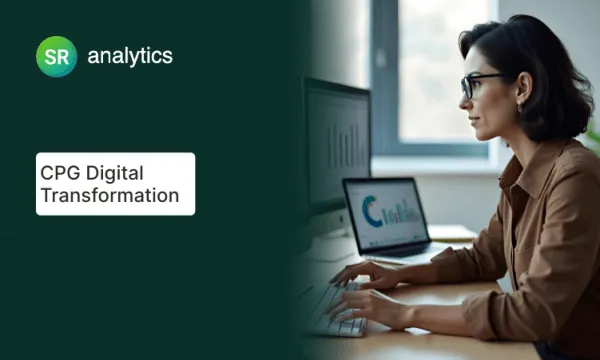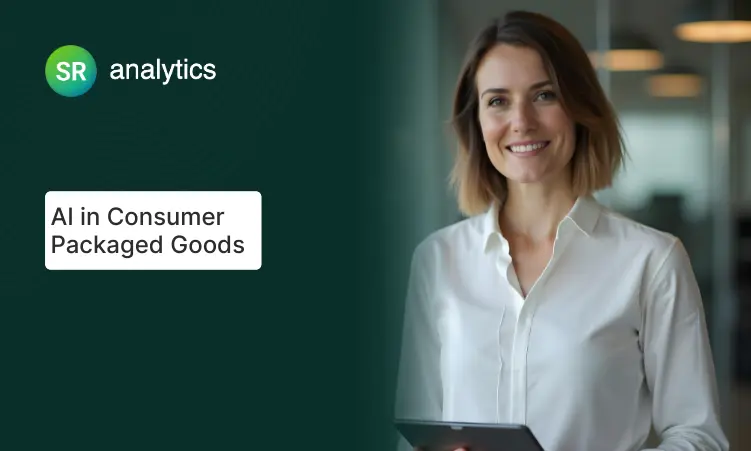Highlights
- CPG companies can achieve 6-10% incremental revenue uplift through comprehensive digital transformation
- 90% of consumer goods executives expect profitable growth despite economic headwinds
- Supply chain AI applications deliver some of the highest ROI in CPG digital initiatives
- Direct-to-consumer channels now contribute over 10% of revenue for 99% of CPG companies
- Only 11% of companies across industries report significant financial benefits from digital initiatives
- Generative AI could unlock an additional $160-270 billion in annual EBITDA for CPG companies globally
Introduction
“Most CPG companies I work with have the same problem: they’re sitting on mountains of data but can’t turn it into decisions. One CEO recently summed it up perfectly—’We’re drowning in data, starving for insights.'”
Here’s what I’ve learned after working with dozens of CPG companies over the past decade: most are sitting on goldmines of information but struggling to turn it into competitive advantage. They know digital transformation is critical, but they’re not sure where to start or how to avoid the expensive mistakes their competitors have made.
The numbers tell a stark story. While 90% of consumer goods executives expect profitable growth in the next two years, only about 11% of companies across industries have achieved significant financial benefits from their digital initiatives so far. That’s a pretty sobering statistic when you consider how much money gets poured into these projects.
But here’s what gives me hope: the companies that get it right see extraordinary results. Full digital and AI adoption can yield 6-10% incremental revenue uplift and 3-5 percentage points of EBITDA margin growth within 3-5 years[1]. I’ve watched brands transform from reactive decision-makers to predictive powerhouses, using data to spot trends before competitors even know they exist.
In this guide, I’ll walk you through real-world examples of CPG companies that have successfully transformed their operations, the specific areas where digital initiatives deliver the highest impact, and the practical frameworks you need to avoid the common pitfalls that derail most transformation efforts.
What Makes CPG Digital Transformation Different from Other Industries
CPG digital transformation presents unique challenges for the CPG industry that I don’t see in other sectors. Unlike pure digital businesses that can pivot quickly, CPG industry companies must balance physical supply chains, complex retail partnerships, and evolving consumer behavior patterns.
Here’s what makes CPG transformation particularly complex:
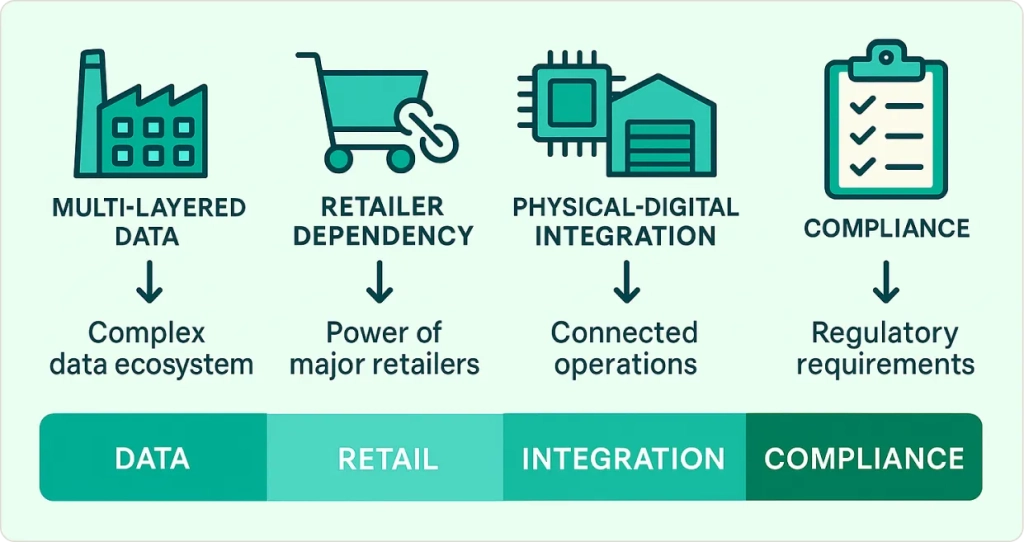
Multi-layered Data Ecosystem: CPG companies generate data across manufacturing, supply chain, sales, marketing, and customer touchpoints. Each layer operates on different systems with varying data quality standards. I’ve seen companies struggle for months just to create a unified view of inventory across their distribution network.
Retailer Relationship Dependencies: Unlike direct-to-consumer brands, traditional CPG companies must work within retailer systems and requirements. Your digital transformation needs to enhance these partnerships, not complicate them. This means building systems that can share data with retail partners while maintaining competitive advantages.
Physical-Digital Integration: CPG success requires seamless integration between physical operations (manufacturing, warehousing, logistics) and digital capabilities (demand forecasting, customer analytics, e-commerce). The companies that excel combine IoT sensors in manufacturing with AI-powered demand planning systems.
Regulatory and Compliance Complexity: Food safety, labeling requirements, and environmental regulations add layers of compliance that digital systems must support. Your CPG digital transformation needs to enhance compliance capabilities, not create new risks.
The CPG industry companies that succeed understand these constraints and design their digital strategies accordingly. They don’t try to become technology companies—they use technology to become better CPG companies.
Real-World CPG Digital Transformation Success Stories
Let me share examples that demonstrate what’s possible when CPG industry companies approach CPG digital transformation strategically.
How Did a Beverage Company Achieve 18% EBITDA Growth?
This case demonstrates how systematic ai in CPG industry implementation can deliver impressive financial results. According to McKinsey digital transformation research[2], one large beverage company achieved an 18% EBITDA increase in just two years.
The Strategic Approach: Senior leaders identified high-impact domains like precision marketing, CPG supply chain digital transformation, and digital procurement. They stood up 50+ cross-functional agile “pods” to rapidly pilot and scale solutions across markets.
The Technology Foundation: They concurrently invested in enabling infrastructure—migrating aggressively to cloud, building a governed data lake, and upskilling talent in analytics to support these initiatives.
The Results: The combination of strong leadership governance and at-scale deployment of AI use cases allowed the beverage company to sustain the improvements and achieve double-digit profit growth in a short time frame.
How Did a Global CPG Leader Save 1.2 Million Work-Hours?
A global CPG leader faced bottlenecks from legacy systems and manual processes affecting everything from R&D to order fulfillment.
The Challenge: Legacy systems and manual processes in R&D, procurement, order-to-cash, and finance were causing significant bottlenecks, delaying product launches and hindering data-driven decisions.
The Transformation: They implemented enterprise workflow automation solutions across global operations, automating critical business processes from product idea assessment to invoice payments.
The Impact: Over 25 new applications deployed in 110+ countries for 3,300+ users, saving 1.2 million work-hours. Specific improvements included:
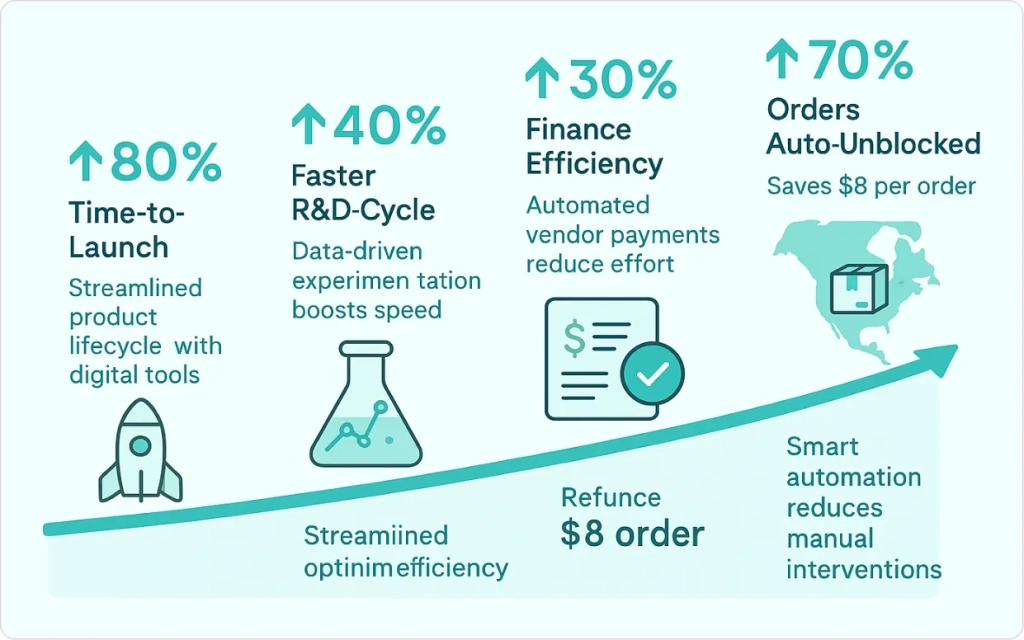
- 80% reduction in time-to-launch for new products
- 40% faster R&D cycle through data-driven assessments
- 30% boost in finance efficiency with automated vendor payments
- 70% of North America orders auto-unblocked, saving approximately $8 per order
Key Areas Where CPG Digital Transformation Delivers Maximum Impact
Based on my experience implementing digital solutions across the CPG value chain, three areas consistently deliver the highest returns on investment.

Procurement and Supply Chain Optimization
This is where I see the most dramatic improvements. CPG supply chain digital transformation consistently delivers the highest returns on investment. AI in CPG industry applications like autonomous planning, CPG procurement digital transformation, and logistics optimization are among the highest-impact areas for boosting profitability.
AI-Driven Demand Forecasting: Modern machine learning models can analyze historical sales, weather patterns, promotional data, and external factors to significantly improve forecast accuracy. Research from McKinsey shows that AI-powered supply chain optimization[3] can reduce forecasting errors by 20-50%. P&G invested in a “resilient supply chain” initiative using a cloud data lake and AI to predict demand more accurately and ensure products are on shelf when and where consumers need them.
CPG Procurement Digital Solutions: E-sourcing platforms and supplier collaboration tools enable better negotiations and cost reductions. One CPG achieved zero-error vendor payments and a 25% increase in “digital negotiation maturity” through automated CPG procurement digital transformation workflows.
Route and Logistics Optimization: AI-powered route planning and warehouse automation reduce freight costs and improve service levels. Combined with IoT tracking, these systems provide end-to-end visibility that enables proactive problem-solving.
Sales and Distribution Transformation
CPG companies managing complex distribution networks can achieve significant gains through digital optimization of route-to-market strategies.
Trade Promotion Optimization: This is critical because trade promotions can account for up to 20% of a food & beverage company’s revenue[4], yet many companies still rely on spreadsheets and gut feel to plan them. Advanced analytics enables smarter decisions about which products, discounts, and timing will yield the best ROI.
Route-to-Market Optimization: Digital tools help prioritize high-value outlets and optimize sales team productivity. Data-driven revenue growth management can boost sales by 3-5 percentage points and gross margins by 200-300 basis points.
Direct-to-Consumer Channel Development: A Salesforce survey in 2023 found 91% of CPG companies now have some form of D2C channel, and for 99% of those, D2C contributes over 10% of revenue. The value extends beyond sales—D2C provides rich first-party customer data for personalized engagement.
Retail Execution Improvement: Digital tools address the fact that nearly 40% of in-store product and marketing initiatives “do not go as intended,” often due to stockouts or poor compliance with display plans.
Marketing and Consumer Engagement
CPG digital transformation in marketing goes far beyond social media advertising. It’s about creating data-driven customer relationships that drive loyalty and lifetime value, addressing key CPG industry challenges around brand loyalty and customer retention.
Consumer 360 Profiles: AI in CPG industry applications analyze consumer attributes and behaviors to enable micro-targeted marketing offers. This reduces waste from overly broad promotions and improves conversion rates.
Content Creation and Media Optimization: AI tools can automate aspects of marketing from creating personalized ad copy to optimizing media spend in real time. According to Deloitte research[5], AI-powered marketing automation can reduce campaign development time by 40-60% while improving targeting accuracy, streamlining content creation and media buying, yielding big savings for CPGs.
Omnichannel Loyalty Programs: With brand loyalty under threat (83% of CPG leaders say it’s harder than ever to maintain loyalty), 70% of CPG companies have now implemented loyalty programs to retain customers and gather direct consumer data.
Our Marketing Analytics consulting helps CPG companies build data-driven marketing strategies that improve customer acquisition and retention.
Expert Framework for Successful CPG Digital Transformation
After guiding numerous CPG transformations, I’ve developed a framework that addresses the unique challenges of this industry.
Step 1: Define Value and Focus Areas
Rather than chasing every technology trend, successful CPG digital transformation initiatives start by answering where the value is. Prioritize domains that drive outsized value: consumer insights, demand generation, and channel management for growth; supply chain and manufacturing for efficiency.
High-Impact Use Cases by CPG Category:
- Food & Beverage: Precision revenue growth management, CPG supply chain digital transformation
- Beauty & Personal Care: Direct-to-consumer innovation, personalized marketing
- Household Products: Manufacturing optimization, retailer collaboration platforms
Step 2: Adopt a Holistic, Dual-Speed Approach
CPG digital transformation is not just an IT project—it must be business-led and enterprise-wide. I recommend a dual approach: modernize core systems (like ERP) while simultaneously driving quick wins with digital initiatives.
Leadership Requirements:
- CEO carries overall responsibility for transformation success
- Business units must actively champion use-case implementation
- Cross-functional teams break silos and accelerate implementation
Step 3: Invest in Data Infrastructure and Accessibility
Data is the lifeblood of digital transformation. Build a unified data platform that can ingest and connect data from ERP, supply chain, sales, and marketing systems. IBM research demonstrates[6] that companies with unified data architectures are 70% more likely to achieve their digital transformation goals.
Key Infrastructure Components:
- Unified data lake or lakehouse architecture
- APIs connecting legacy and new systems
- Real-time data processing capabilities
- Self-service analytics tools for business users
Step 4: Cultivate Digital Culture and Talent
Technology alone doesn’t guarantee success—people and processes must transform in parallel. MIT Sloan research shows[7] that 70% of digital transformation initiatives fail due to inadequate change management. This means instilling an agile, test-and-learn culture and investing in training.
Cultural Transformation Requirements:
- Encourage experimentation with fail-fast mindset
- Establish clear metrics for digital pilots
- Invest in retraining employees on digital tools
- Change reward systems to incentivize data-driven decisions
Common Implementation Pitfalls and How to Avoid Them

Based on my experience, here are the most critical mistakes to avoid:
Pitfall 1: Technology-First Approach
Many CPG industry companies start with technology selection rather than business strategy. This leads to expensive implementations that don’t address real CPG industry challenges.
Solution: Start with business objectives and work backward to technology requirements. Ask “What business problems are we solving?” before “What technology should we buy?”
Pitfall 2: Underestimating Change Management
Technical implementation is often easier than organizational change. Teams struggle to adopt new workflows and collaborative approaches.
Solution: Invest 20-30% of project budget in change management and training. Create early wins that demonstrate value to build momentum.
Pitfall 3: Inadequate Data Quality
Digital transformation often exposes existing data quality issues that were hidden by manual processes.
Solution: Treat transformation as an opportunity to improve data quality fundamentals. Implement data governance frameworks from day one.
Pitfall 4: Lack of Stakeholder Alignment
Different departments often have conflicting priorities and success metrics for digital initiatives.
Solution: Establish clear governance structures and shared success metrics across all stakeholders before beginning implementation.
Measuring ROI and Success in CPG Digital Transformation
To properly evaluate CPG digital transformation ROI, consider these often-overlooked factors that separate successful initiatives from expensive failures:
Cost Savings Opportunities
- Eliminated licensing for replaced tools
- Reduced data integration and development costs
- Decreased infrastructure management overhead
- Lower training costs through unified platforms
Productivity Gains
- 30-50% reduction in data pipeline development time
- Faster time-to-insight for business users
- Elimination of data movement between analytics tools
- Improved collaboration between data teams
Business Value Creation
- Enhanced decision-making through integrated analytics
- New analytics capabilities enabling operational improvements
- Improved data governance and compliance
- Scalability for future data growth
Typical ROI Timeline: Most organizations see positive returns within 12-24 months, with full value realization in 2-3 years.
The Future of CPG Digital Transformation
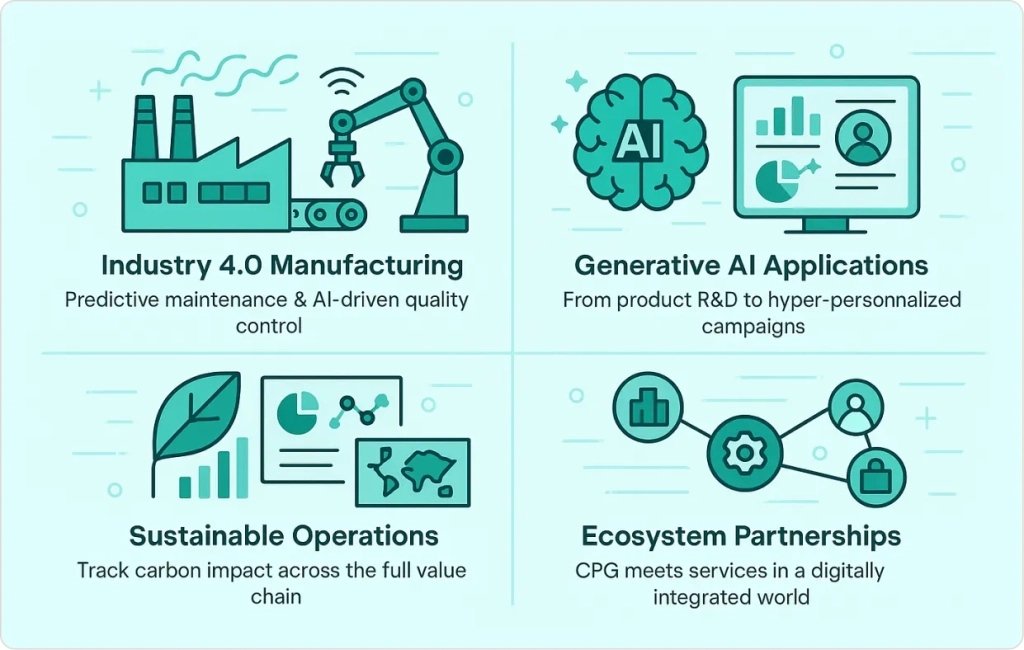
Looking ahead, expect CPG industry companies to double down on several key areas that address persistent CPG industry challenges:
Industry 4.0 Manufacturing: IoT sensors, predictive maintenance, and ai in CPG industry quality control applications will become standard across CPG manufacturing operations.
Generative AI Applications: From product formulation to personalized marketing content, generative AI will enable new levels of innovation and efficiency for CPG digital transformation.
Sustainable Operations: Digital tools will be essential for tracking and optimizing environmental impact across the entire value chain.
Ecosystem Partnerships: CPG industry companies will increasingly participate in digital ecosystems, extending beyond traditional product categories into related services.
Case Study: How We Helped a CPG Client Transform Their Supply Chain
Recently, we worked with a mid-sized food and beverage company struggling with inventory management and demand forecasting. Their challenge was typical: multiple data sources, manual processes, and reactive decision-making.
The Challenge: Frequent stockouts of popular products while carrying excess inventory of slow-moving items, resulting in increased carrying costs and lost sales opportunities.
Our Solution:
- Implemented unified data platform connecting ERP, POS, and external market data
- Built AI-powered demand forecasting models incorporating seasonality and promotional impacts
- Created real-time dashboards for inventory optimization
- Established automated alerting for reorder points and promotional planning
The Results:
- 23% reduction in stockouts
- 18% decrease in overall inventory levels
- 15% improvement in forecast accuracy
- $2.3M annual savings in carrying costs
“The transformation didn’t just improve our numbers—it changed how we think about using data across our entire organization,” said their VP of Operations.
Conclusion: Your Path Forward in CPG Digital Transformation
The evidence is clear: CPG companies that embrace digital transformation strategically are achieving significant competitive advantages. But success isn’t guaranteed by technology alone—it requires thoughtful planning, strong execution, and commitment to organizational change.
The companies that win will be those that use digital tools to enhance their core strengths: understanding consumers, optimizing operations, and building strong brand relationships. They won’t try to become technology companies—they’ll become data-driven CPG industry companies that leverage CPG digital transformation and CPG analytics to solve real business challenges.
Whether you’re just starting your digital journey or looking to accelerate existing initiatives, the key is to start with business objectives and work systematically toward integrated capabilities. The future belongs to CPG industry companies that can turn data into decisions and insights into action through strategic CPG digital transformation.

